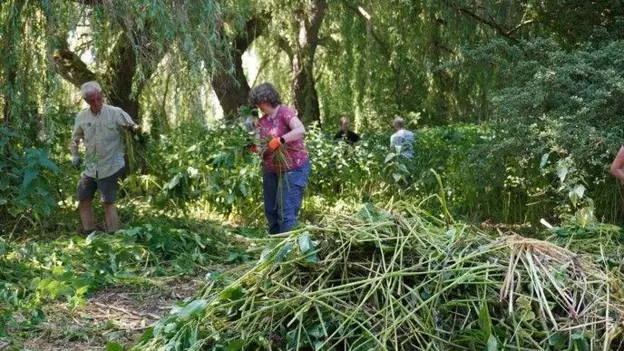| Re: Why people are ripping flowers from local waterways - Nottinghamshire, 2025 Posted by johnneyw at 19:10, 5th August 2025 |     |
I've read quite a lot about "Balsam Buster" groups being busy all over the country. To add to the solutions, I've also been reading about the introduction of a fungus rust specific only to Himalayan Balsam which looks to control rather than wipe out the plant giving native species the opportunity to compete. Test results are apparently encouraging although it works better in some locations than others, the reasons for which are still being investigated.
| Why people are ripping flowers from local waterways - Nottinghamshire, 2025 Posted by Chris from Nailsea at 08:37, 5th August 2025 |     |
From the BBC:

Thousands of plants along Nottingham's waterways are being ripped out by the root.
Volunteers have spent more than 1,000 hours during the summer getting rid of Himalayan balsam - often seen in swathes with pretty pink flowers. But the invasive species, originating from the harsh mountain conditions of the Himalayas, is thriving here in the UK at the risk of local ecosystems.
Nottinghamshire Wildlife Trust has been running a project to protect wildlife and get rid of the invasive plants.
Himalayan balsam is a wild flowering plant that can grow up to two metres tall and grows large pink, bonnet-shaped flowers. Although they originate from the Himalayas, they are commonly seen in the UK, particularly along riverbanks.
Miriam Lawley, from Nottinghamshire Wildlife Trust, is helping to deliver the 'Thriving in a Wilder Trent Project'. She explained that the plant was first introduced to the UK almost 200 years ago. "It was brought over first by the Victorians," she said. "Because it was such an attractive plant, they wanted to introduce it to their gardens."
Its place of origin means the "well-evolved and adapted" species can survive pretty much "anywhere", according to expert Ms Lawley. "Once it was brought over by the Victorians it kind of hit the jackpot because living is much easier here where the soil is quite fertile," she added.
In the UK, the plant is typically found along waterways because rivers and streams help to spread its seed. Because of that, the plant is prevalent on sites along the River Trent, including Attenborough Nature Reserve.
The plant usually starts to appear in May - or April, following a warm winter - and is found throughout the summer until August.
The species has an "explosive seed pod mechanism" which helps it scatter its seeds. Each individual plant can produce up to 800 seeds and and once ripe, the seed pods split open, spreading them as far as about seven metres.
"It very rapidly becomes a big problem in the UK when you have that many seeds spreading over such a large area," Ms Lawley said.
It was that mechanism that helped the plant spread beyond Victorian gardens and into natural areas. While Himalayan balsam might look pretty once flowered, it comes with a threat to local biodiversity, Ms Lawley said. By taking over large areas of natural land, the plant "out-competes" a lot of native plants that insects rely on.
Ms Lawley said: "One of the things that a lot of people think about Himalayan balsam is that it's really good for bees because we often see a lot of them flying around. Many of them are attracted to this really sweet smell but a lot of them can't actually get into the deep flowers to get the pollen because they've not evolved alongside this kind of flower. So we actually find that there's a lot of insect declines where Himalayan balsam is really prevalent, as well as the decline in native plants."
(BBC article continues)










